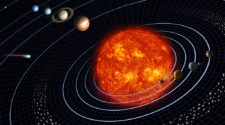APRIL 5, 1861: An amateur astronomer in New York, A.E. Thatcher, discovers a 9th-magnitude comet. Comet Thatcher was found to have an approximate orbital period of 415 years and is the parent comet of the Lyrid meteor shower, which peaks around April 22 each year. The Lyrids usually put on a modest display of less than 20 meteors per hour, but on occasion have produced much stronger displays, most recently in 1982.
APRIL 8, 1957: Comet Arend-Roland 1956h passes through perihelion at a heliocentric distance of 0.316 AU. This was one of the brighter comets of the mid-20th Century and is a future “Comet of the Week.”
APRIL 8, 2024: The path of a total solar eclipse will cross north-central Mexico and the south-central and northeastern U.S. This may be my last, best chance to see an eclipse comet; I discuss these in a future “Special Topics” presentation.
APRIL 9, 1994: Radar bounce experiments conducted by the joint NASA/U.S. Defense Department Clementine spacecraft suggest the presence of water ice in permanently shadowed craters near the moon’s South Pole. This would be confirmed by NASA’s Lunar Prospector mission in 1998. These experiments are discussed as part of a future “Special Topics” presentation.
APRIL 10, 837: Comet 1P/Halley makes the closest approach it has made to Earth in recorded history, 0.033 AU. The history of Comet Halley is covered in a previous “Special Topics” presentation.
APRIL 10, 1986: Comet 1P/Halley makes its closest approach to Earth of its 1986 return, 0.417 AU. The 1986 return of Halley is a previous “Comet of the Week.”
APRIL 10, 1989: Karen Meech and Michael Belton make the first reported detection of a coma around the centaur (2060) Chiron. This detection allowed Chiron to be dual-designated as Comet 95P/Chiron, and it and other centaurs are discussed in a previous “Special Topics” presentation.

APRIL 11, 1984: The Solar Maximum Mission (SMM) spacecraft is redeployed from the Space Shuttle Challenger following its repair by onboard astronauts. SMM would go on to discover several Kreutz sungrazing comets before entering the Earth’s atmosphere in late 1989. Kreutz sungrazers are the subject of a future “Special Topics” presentation.
APRIL 11, 1996: The Spacewatch program in Arizona discovers the near-Earth asteroid now known as (68503) Didymos. A small moon – informally nicknamed “Didymoon” – accompanying Didymos was discovered in 2003, and this asteroid pair is the planned destination of NASA’s Double Asteroid Redirection Test (DART) mission, currently scheduled for launch in July 2021. DART and other future “small bodies” missions are covered in this week’s “Special Topics” presentation.
More from Week 15:
Comet of the Week Special Topic Free PDF Download Glossary
Ice and Stone 2020 Home Page


